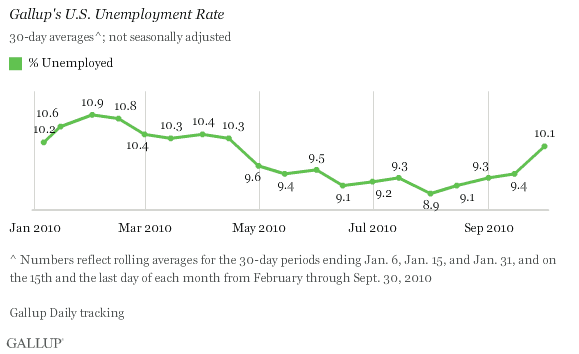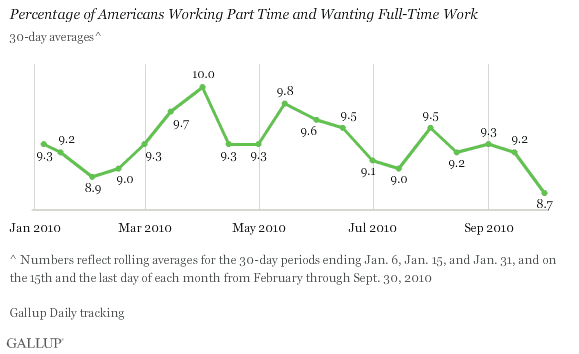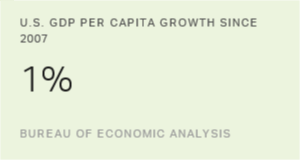PRINCETON, NJ -- Unemployment, as measured by Gallup without seasonal adjustment, increased to 10.1% in September -- up sharply from 9.3% in August and 8.9% in July. Much of this increase came during the second half of the month -- the unemployment rate was 9.4% in mid-September -- and therefore is unlikely to be picked up in the government's unemployment report on Friday.

Certain groups continue to fare worse than the national average. For example, 15.8% of Americans aged 18 to 29 and 13.9% of those with no college education were unemployed in September.
The increase in the unemployment rate component of Gallup's underemployment measure is partially offset by fewer part-time workers, 8.7%, now wanting full-time work, down from 9.3% in August and 9.5% at the end of July.

As a result, underemployment shows a more modest increase to 18.8% in September from 18.6% in August, though it is up from 18.4% in July. Underemployment peaked at 20.4% in April and has yet to fall below 18.3% this year.

Friday's Unemployment Rate Report Likely to Understate
The government's final unemployment report before the midterm elections is based on job market conditions around mid-September. Gallup's modeling of the unemployment rate is consistent with Tuesday's ADP report of a decline of 39,000 private-sector jobs, and indicates that the government's national unemployment rate in September will be in the 9.6% to 9.8% range. This is based on Gallup's mid-September measurements and the continuing decline Gallup is seeing in the U.S. workforce during 2010.
However, Gallup's monitoring of job market conditions suggests that there was a sharp increase in the unemployment rate during the last couple of weeks of September. It could be that the anticipated slowdown of the overall economy has potential employers even more cautious about hiring. Some of the increase could also be seasonal or temporary.
Further, Gallup's underemployment measure suggests that the percentage of workers employed part time but looking for full-time work is declining as the unemployment rate increases. To some degree, this may reflect a reduced company demand for new part-time employees. For example, employers may be converting some existing part-time workers to full time when they are needed as replacements, but may not in turn be hiring replacement part-time workers. Another explanation may relate to the shrinkage of the workforce, as some employees who have taken part-time work in hopes of getting full-time jobs get discouraged and drop out of the workforce completely -- going back to school to enhance their education, for example, instead of doing part-time work. It is even possible that some workers may find unemployment insurance a better alternative than part-time work with little prospect of going full time.
Regardless, the sharp increase in the unemployment rate during late September does not bode well for the economy during the fourth quarter, or for holiday sales. In this regard, it is essential that the Federal Reserve and other policymakers not be misled by Friday's jobs numbers. The jobs picture could be deteriorating more rapidly than the government's job release suggests.
Gallup.com reports results from these indexes in daily, weekly, and monthly averages and in Gallup.com stories. Complete trend data are always available to view and export in the following charts:
Daily: Employment, Economic Confidence and Job Creation, Consumer Spending
Weekly: Employment, Economic Confidence, Job Creation, Consumer Spending
Read more about Gallup's economic measures.
Gallup classifies American workers as underemployed if they are either unemployed or working part time but wanting full-time work. The findings reflect more than 18,000 phone interviews with U.S. adults aged 18 and older in the workforce, collected over a 30-day period. Gallup's results are not seasonally adjusted and tend to be a precursor of government reports by approximately two weeks.
Results are based on telephone interviews conducted as part of Gallup Daily tracking Sept. 1-30, 2010, with a random sample of 18,146 adults, aged 18 and older, living in all 50 U.S. states and the District of Columbia, selected using random-digit-dial sampling.
For results based on the total sample of national adults, one can say with 95% confidence that the maximum margin of sampling error is ±1 percentage point.
Interviews are conducted with respondents on landline telephones and cellular phones, with interviews conducted in Spanish for respondents who are primarily Spanish-speaking. Each daily sample includes a minimum quota of 150 cell phone respondents and 850 landline respondents, with additional minimum quotas among landline respondents for gender within region. Landline respondents are chosen at random within each household on the basis of which member had the most recent birthday.
Samples are weighted by gender, age, race, Hispanic ethnicity, education, region, adults in the household, cell phone-only status, cell phone-mostly status, and phone lines. Demographic weighting targets are based on the March 2009 Current Population Survey figures for the aged 18 and older non-institutionalized population living in U.S. telephone households. All reported margins of sampling error include the computed design effects for weighting and sample design.
In addition to sampling error, question wording and practical difficulties in conducting surveys can introduce error or bias into the findings of public opinion polls.
For more details on Gallup's polling methodology, visit www.gallup.com.
